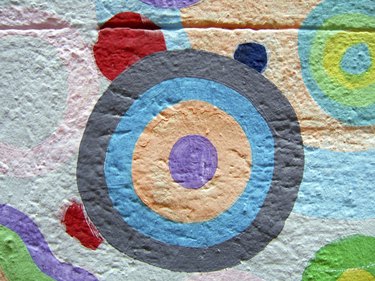Things You'll Need
Feather duster or dust rag
Painter's tape
Dropcloth
String or thread
Chalk
Tape measure
Scissors
Rag
Latex paint
Paint tray
Paint stirrer
Artist's brush
Paintbrush

Painting a perfect circle -- especially a large one -- over an interior or even an exterior wall is difficult, if not impossible, to accomplish without a guideline, tool or template for the circle form. Create your own compass with chalk and string to draw the circles on the wall; then fill in the chalk lines with paint. Apply a base coat of paint in the desired background color, and use another color or a high-gloss version of the base shade on the circles for visual contrast.
Step 1
Wipe the wall clean with a feather duster or dust rag to remove dust and debris.
Video of the Day
Step 2
Cover areas you do not wish to paint, such as the baseboards, with painter's tape. Place a dropcloth on the floor in front of the project wall.
Step 3
Tie one end of the string or thread snugly around a piece of chalk. Unravel more string or thread until the length is half the size of the desired circle. If you wish to create a circle of a specific size, measure the string to half that length using a tape measure. For instance, a 4-foot diameter circle requires 2 feet of string from the tip of the piece of chalk to the end of the string. Cut the string with scissors at this length.
Step 4
Hold the loose end of the string against the wall at the center point of the envisioned circle. Pull the string taut with your free hand, or enlist a friend's help. Arc the chalk along the wall, keeping the string taut and the loose end of the string pressed firmly against the wall. One complete arc rotation of the chalk creates a perfect circle on the wall.
Step 5
Step back from the wall and examine the circle's placement. If you're happy with the positioning, repeat the process with each additional circle required for the project. If not, wipe away the chalk with a rag and redraw the circle in another location.
Step 6
Open and stir the latex paint, pouring some into a paint tray. Dip an artist's brush into the paint and trace the outline of the chalk circle or circles on the wall. Hold the brush with your arm positioned inside the wall, arcing your arm or wrist a bit as you paint for a smoother circle; working from the outside in may prove awkward. Make the outline as thick as you wish, adding more paint to the inside, rather than the outside, of the circle.
Step 7
Fill in the circle by dipping a larger paintbrush into the paint, painting inside the thin circle created with the artist's brush. Allow the paint to dry completely; then apply a second coat if the base paint color is still visible beneath the circle's paint.
Tip
If you're using the same size circle repeatedly over the wall, you may wish to make a stamp instead of using a homemade compass each time. Use your string-based compass, this time tied to a nail or awl, to scratch the circle shape into a large sheet of shipping foam. Hold the end of the string near the center of the foam; then pull the string taut as you use the awl or nail tip to carve into the foam. Continue carving areas of the foam away; then break off excess pieces by hand or by using a utility knife. Dip the foam into paint to stamp designs on the wall, or brush paint onto the stamp; then stamp the wall.
Warning
Take your time while painting the outline of the circle, as the outline portion is your chance to make the circle look as smooth as possible.
Hold the loose end of the string securely at all times; if the string slips even half an inch while you're drawing the chalk arc, it affects the shape of the circle.
Video of the Day